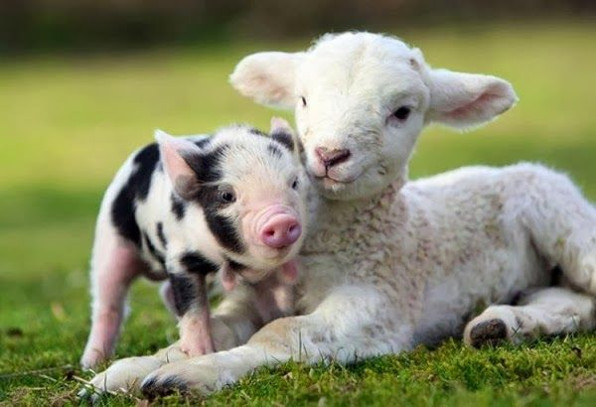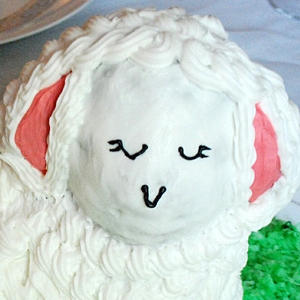Lamb is the traditional meat eaten by folks throughout Christendom at Easter, marking the crucifixion of Jesus Christ and his subsequent resurrection. But Lamb has surprising connections with Pagan religious observances that go back well before Christianity came upon the scene…
 Lamb and Ham – together as they should be, for Easter…
Lamb and Ham – together as they should be, for Easter…
In the British comedy series Hot Metal (London Weekend Television, 1986-88) which spoofed the newspaper business, boorish tabloid publisher Twiggy Rathbone describes compassion as ‘the Mint Sauce on the Lamb of God’. High satire, to be sure, but not that far off the mark, as history shows.
Early beginnings…
Lamb was a traditional part of early Jewish Passover observances even before Christ was born. Tradition says the Jews marked the doors of their homes with the blood of sacrificed Lambs so they would be ‘passed over’ by God when he punished sinners by killing their first-born sons. Historically, it was a time of great plagues, and many sons were, no doubt, dying as a result. Also, Lambs were the first of the new spring crop of livestock to appear after a long and hungry winter.
When Jews began converting to Christianity, some brought with them the tradition of roasting a Lamb at Easter for good luck and to ensure God’s Grace.
In addition, and possibly as a result of the adoption of the old tradition by the new religion, Christ himself is often referred to as The Lamb of God, who sacrificed himself so his followers could live. During the Last Supper, Christ told his disciples to partake of his ‘body’ and ‘blood’, ‘in remembrance of me’. Thus, the origin of the Communion.
It’s no wonder that Lamb takes precedence as the Meat of choice at Easter.
But what about Ham?
This one, too, has its roots back in the mists of history, in an old story about Noah’s great-grandson Nimrod and his mother/wife, Semiramis. Together they had a son named Tammuz who became a great hunter – until he was gored to death by a wild boar. Semiramis decreed that her son be memorialized by an annual 40-day fast, to be broken by the roasting of a pig. Hence the source of the tradition of Lent, and the connection of Ham to Easter.
As a sidelight, Semiramis eventually set herself up as the head of a new Pagan religion, renaming herself Ishtar. From there, it wasn’t a very long reach to ‘Easter’.
On a more practical note, Hogs are traditionally slaughtered in the fall with Hams left to cure over the winter. They would be ready to eat – in season – right about now.
Why Fish on Friday?
To be specific, Christian tradition requires that Fish be eaten on Friday – Good Friday, specifically. It’s the last day of Lent (the marathon fast mentioned earlier), during which meat is not be eaten. Christ’s first disciples were fishers, so they are honoured by the command to eat Fish.
What have Eggs got to do with it?
‘Eggs at Easter’ is another tradition imported from Pagan observances, specifically the celebration of Spring and the coming of new life to the Earth.
Christians associate Eggs with the resurrection of Jesus at Easter, as a result of which he enjoyed new life. The tradition goes back to the 13th century. It was forbidden to eat Eggs during Lent, so folks celebrated the end of the fast by decorating Eggs with intricate designs and eating them at Easter.
Okay. We might as well explore the ‘Bunny’, tradition, too…
Like Eggs, Rabbits – legendary for their energetic procreation – were associated from very early times with fertility and new life. The tradition is believed to have come from Germany, where folks encouraged their kids to make nests in which the ‘Osterhase’, or Easter Bunny, could lay her Eggs. Over time, Eggs were replaced by Candy, Chocolate and other gifts.
But nowhere I looked did anyone offer a theory as to why the Easter Bunny lays Eggs in the first place. Bunnies are, after all, mammals…
~Maggie J.

